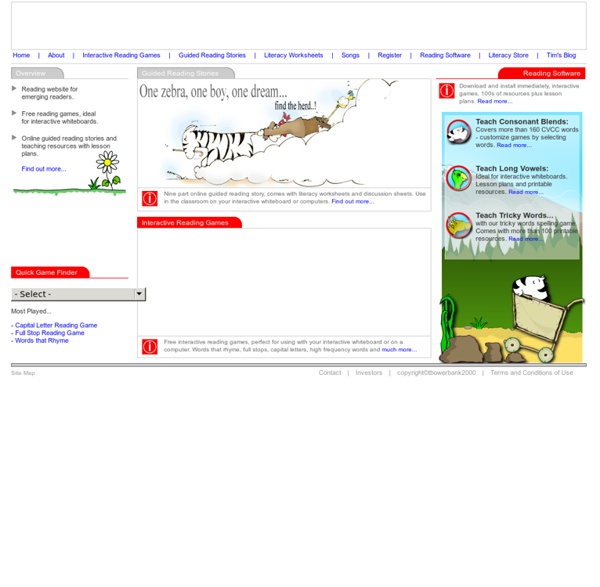



http://roythezebra.com/index.html
Literature Learning Ladders Literature Circles involve a small group of students exploring a piece of literature in depth. Although you'll find lots of books and articles on the Literature Circles, there are many ways to implement the strategies across grade levels and subject areas. Think of literature circles as one element of a balanced literacy program rather than "the solution." In most cases, the application of literature circles evolves over time as students and teachers become more experienced readers. Check out the off-site resources by Katherine L. Schlick Noe titled Overview of Literature Circles.
Welcome to the Don Potter.net Wide Interest Web Site Nationwide Educational Reform Campaign Sponsored by Donald L. Potter Don teaching Blend Phonics Unit 14 with cursive Purpose Statement What's wrong with CA reading list By Mark Bauerlein Mark Bauerlein is a professor in the Department of English at Emory University and the author of The Dumbest Generation : How the Digital Age Stupefies Young Americans and Jeopardizes Our Future; Or, Don’t Trust Anyone Under 30. Last month, the California Department of Education issued Recommended Literature: Pre-Kindergarten Through Grade Twelve , an updated reading list of books for teachers of English, science, and social studies to use in their classrooms.
Magic Tree House #16 Hour of the Olympics Magic Tree House #16 Hour of the Olympics By Mary Pope Osborne Jack and Annie get to travel to Greece at the time of the ancient Olympics. They recover a lost poem written by a young woman, meet Plato the philosopher and get to go to the Olympics. Chapter 1 Where are Jack and Annie going on this adventure? McREL Blog: Balancing the Common Core: Leveled readers vs. complex text The art of teaching requires many careful balancing acts, and implementing the Common Core State Standards (CCSS) for literacy offers an opportunity for one more. We’ve heard a lot about the CCSS’ focus on complex texts; however, this doesn’t mean texts matched to students’reading levels aren’t still important. It takes both to build competent and fluent readers. Elementary classrooms and libraries across the country are filled with leveled readers, or books categorized into reading levels. During literacy blocks, many teachers carefully and systematically ensure that each student is assigned to a reading group or given a selection of texts for independent reading based on his or her assessed reading level. This is common practice in reading instruction and is, in fact, the centerpiece of popular curricula such as Lucy Calkins’ Reading and Writing Project .
Document Analysis Worksheets Document analysis is the first step in working with primary sources. Teach your students to think through primary source documents for contextual understanding and to extract information to make informed judgments. Use these worksheets — for photos, written documents, artifacts, posters, maps, cartoons, videos, and sound recordings — to teach your students the process of document analysis. Characteristics of Literacy-Rich Content-Area Classrooms ASCD Characteristics of Literacy-Rich Content-Area Classrooms Vicki Urquhart and Dana Frazee What does today's classroom look like when teachers intentionally plan lessons that support adolescent literacy development? Research provides an answer: "School and classroom cultures that successfully promote the development of adolescent literacy skills are characterized by connections, interaction, and responsiveness, which lead to student engagement and reflection" (Meltzer, 2001).
- 14 Amazing Project Sites: A STEM, PBL, Common Core Series - A Goldmine of Resources 0 Comments June 8, 2013 By: Michael Gorman Jun 8 Written by: 6/8/2013 3:20 PM Express 8.02 - Field Notes: How to Help Struggling Students with Life Space Crisis Intervention Field Notes How to Help Struggling Students with Life Space Crisis Intervention Mark Anderson
Textmasters: Shaking Up Textbook Reading in Science Classrooms ReadWriteThink couldn't publish all of this great content without literacy experts to write and review for us. If you've got lessons plans, activities, or other ideas you'd like to contribute, we'd love to hear from you. More Find the latest in professional publications, learn new techniques and strategies, and find out how you can connect with other literacy professionals. More Teacher Resources by Grade
Top Ten Middle Grade Read Alouds That Will Have Kids Rolling on the Floor Laughing by Cathy Potter August is the month when classroom teachers are thinking about their plans for the new school year. One important decision is which books will be read aloud to students. There have been many Twitter conversations and blog posts recently about choosing just the right read aloud for the beginning of the year. Third grade teacher, Franki Sibberson, wrote about the importance of choosing just the right read aloud on her blog, A Year of Reading. Common Core Literacy Standards for Science and Technical Subjects, Summarized Through a colleague on Twitter, I came across this great post from Mark Clements about how he had taken the Social Science CCSS Literacy standards, summarized them, and re-grouped them, in an attempt to make them easier to digest for teachers who may not be very familiar with Common Core. Since I will be working with Science teachers later this month, to introduce the CCSS Literacy standards for Science and Technical Subjects, I was inspired to follow his example with the Science standards. Here's what I came up with. First, the Reading standards, summarized: Next, the Writing standards, similarly shortened: From these restatements, I was able to group the standards into four categories: